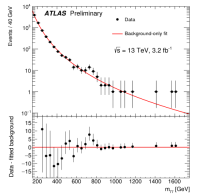
Father Christmas will soon be on his way to the International Space Station. (Courtesy: NASA)
By Hamish Johnston
In this festive edition of the Red Folder, NASA has come up with a great way for youngsters to spot Santa’s sleigh as it streaks across the sky on Christmas Eve. It turns out that Santa hitches a ride with the International Space Station, so you can use NASA’s Spot the Station tool to find out when Father Christmas will be visible above your town. A search on Bristol, UK reveals that Santa will be overhead at 17:21 – perfect for getting the children to bed early.
Hoverboards had looked set to be the hot gift this Christmas, but now the news is full of horror stories about the two-wheeled contraptions bursting into flames. Blogger Sabine Hossenfelder has written a wonderful self-described “rant” about an article in Wired by the physicist Rhett Allain called “You can’t ride a hoverboard without Einstein’s theory of general relativity”. In the true spirit of a Christmas pantomime, Hossenfelder’s response is “Oh yes you can”.
Undeterred, Allain has just posted a new item on Wired that looks at the physics – or lack thereof – in this Christmas’s blockbuster film: “The physics in Star Wars isn’t always right and that’s ok”. I look forward to Hossenfelder’s riposte!

Plucked from the heavens. (Courtesy: I Love Science Store)
A much safer Christmas gift that’s also out of this world can be found at the I Love Science Store. On offer are sterling silver pendants set with a meteorite from Campo del Cielo – or “Field of Heaven” – in Argentina. It was there about 4500 years ago that 26 craters were made as iron meteorites struck the Earth. About 100 tonnes of meteorite material has been recovered from the crater field and a tiny piece of it can be yours for $84.99.
There is one group of physicists who will be disappointed with what Father Christmas has left in their stockings this Christmas. Earlier this week at CERN, scientists working on the CMS and ATLAS experiments presented an initial analysis of data collected during the 13 TeV run of the Large Hadron Collider (LHC). Sadly, it doesn’t look good for theoretical physicists who are struggling to make sense of what lies beyond the Standard Model of particle physics.
Rather than finding evidence for theories such as supersymmetry (SUSY) – which some physicists believe should emerge within 13 TeV proton collisions – the best the data could do is increase the lower limit on the masses of the gluino and the sbottom quark. These are hypothetical SUSY particles, or “sparticles”, which the theory predicts will be produced in the LHC, and the latest data suggest that SUSY proponents may have to wait a little while longer before their theory can be validated. SUSY sceptic-in-chief Peter Woit offers his “glass half empty” analysis on his Not Even Wrong blog.
On a positive, albeit much more speculative note, by Christmas 2016 particle physicists could be rejoicing over the birth of a new boson not described by the Standard Model. It seems that there is growing evidence from both CMS and ATLAS that a “diphoton peak” at about 750 GeV is emerging from the data. There is a very good explanation of what this mysterious peak could mean on the Résonaances blog: “A new boson at 750 GeV?”.
If this sounds familiar, it’s because evidence for the Higgs boson emerged from collider data as a diphoton peak created when the Higgs decays to two photons with total energy of about 125 GeV – the mass of the Higgs. So one possible explanation for the nascent peak is a completely new boson with a mass of 750 GeV, which would be a fantastic gift to the theoretical particle physics community.
The diphoton peak itself has a statistical significance of as much as 3.9σ (2.3σ after a “look elsewhere” correction), which is a long way from the 5σ needed for a discovery. But Christmas is traditionally a time of hope, so fingers crossed!
And on that note I would like to wish all of our readers a very merry Christmas and a happy New Year.

Dr. Johnston, let us hope that the situation of the 750 GeV bump would be clarified one way of the other by the LCH’s 13 TeV run next year. In the mean time, all the best for the next year.
Trackback: Blog - physicsworld.com